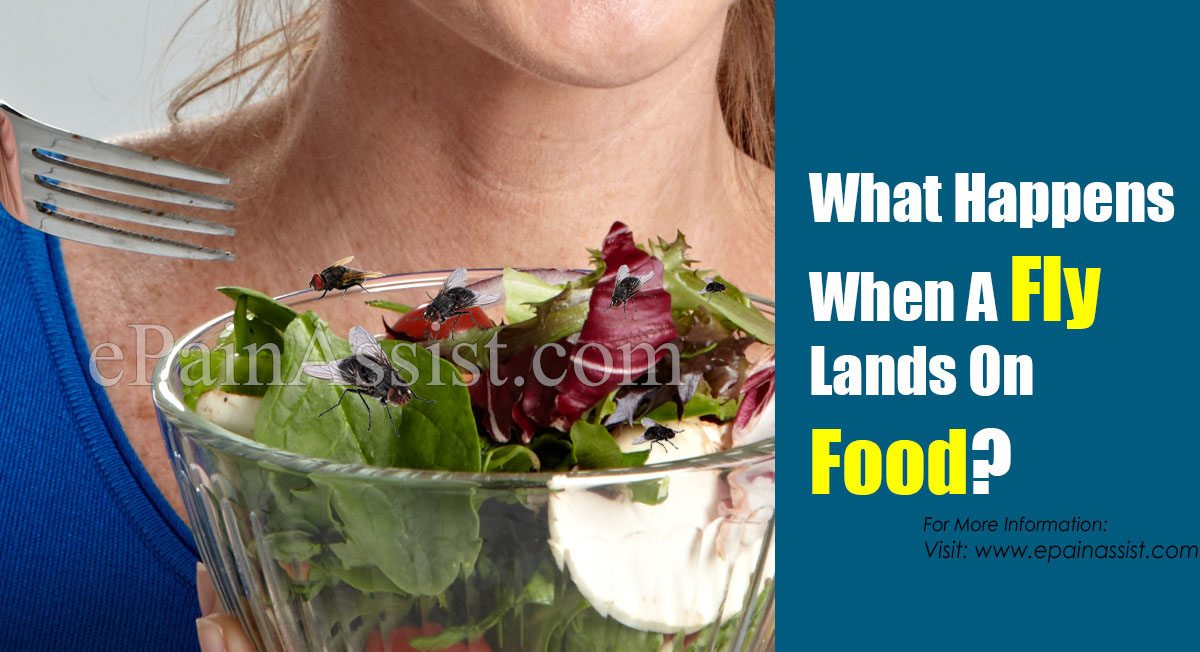Once the fly picks germs it can easily spread it. The bacteria and viruses can easily stick to the fly’s body and the tiny hair on its legs.
If the fly carrying bacteria or virus lands on the food, it can leave some of them there, putting us at risk of enteric infection such as dysentery, typhoid, cholera, and certain helminth infection(1, 2)
According to Penn State’s Department of Entomology, houseflies are capable of transmitting at least 65 diseases to human(3)

Also, a fly when lands on the food, does not nibble on it or eat its bits, instead, it vomits its digestive juices onto the food. The vomit contains germs from its last meal. The pathogens inside the fly last longer than those on its feet.
How Does A Fly Spread Germ?
A few minutes or seconds after a fly lands on the food, it starts exploring the new terrain for food. If it finds the substance meal-worthy, it would spurt its saliva onto the surface.
Flies do not have teeth, they spurt saliva on food to liquefy it so that it can be sucked and swallowed.
Along with regurgitation, the fly might also defecate as it explores the new surfaces.
The way the fly spreads infection on your food also depends on its travel before it landed on your food. It might have visited some dumpsters, dog poop, or farm and animal carcasses in rural areas. The fly might have ingested bacteria or carried it along with its wings, feet, and mouth.
Other factors such as species of bacteria, amount of bacteria, proximity to the source of bacteria, and even the sex of the fly play a role in determining what would happen if a fly lands on the food.
Diseases Spread By A Fly
The stomach of flies is overload with germs. The previous meals they sat on and their gastric juices make a perfect recipe for diseases. The germs carried by the fly are very scary.
More research in needed to identify the pathogens spread by a housefly but it is believed to spread hepatitis A, salmonella, E.coli, and even rotavirus(2).
It can also spread shigella, a group of bacteria that can lead to diarrhea, fever, and stomach pain.
In countries with poor sanitation, the fly might harbor pathogens from human waste and lead to deadlier diseases like cholera, vibriosis, or dysentery.
Those eating a lot of roadside food, or from the restaurants that do not contain proper sanitation are more at the risk of salmonella, hepatitis A and rotaviruses.
How To Be Safe?
Flies infect your food, but this does not mean you throw away all the food they land on.
If you have a strong immune system or follow strict hygiene and sanitation at home, the chances of infection would be rare.
Also if your house is clean and the fly has landed once on your food and you can probably eat it safely.
The bigger worry lies when you are in a crowded place with the area buzzing with bugs. More the flies land on your meals, more germs they could leave.
You can save your food while at a picnic; you can cover the food with a net to prevent the flies from sitting and spoiling it.
But, if you find a lot of flies buzzing around the food that is left uncovered, the safest bet would be to throw it away.
